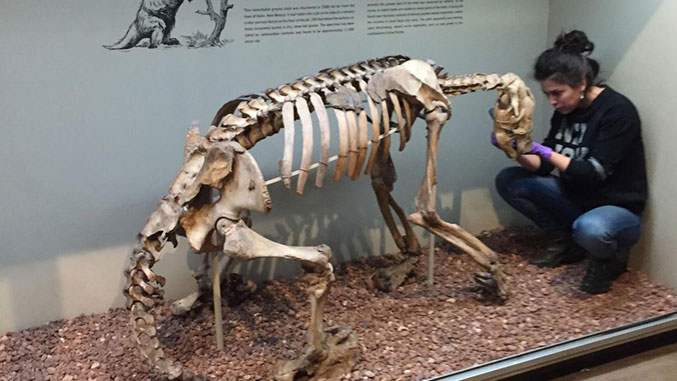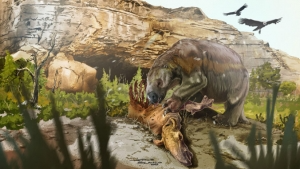Extinct Ground Sloth Was An Omnivore, Not Vegetarian
A study co-authored by University of Hawaiʻi at Mānoa scientists suggests that Mylodon—a ground sloth that lived in South America until about 10,000 to 12,000 years ago—was not a strict vegetarian like all of its living relatives.
 Julia Tejada sampling a specimen of the North American ground sloth. (Copyright: Julia Tejada) Based on a chemical analysis of amino acids preserved in sloth hair, the researchers uncovered evidence that this gigantic extinct sloth was an omnivore, at times eating meat or other animal protein in addition to plant matter.
Julia Tejada sampling a specimen of the North American ground sloth. (Copyright: Julia Tejada) Based on a chemical analysis of amino acids preserved in sloth hair, the researchers uncovered evidence that this gigantic extinct sloth was an omnivore, at times eating meat or other animal protein in addition to plant matter.
Led by researchers at the American Museum of Natural History and published in Scientific Reports, the study contradicts previous assumptions about the animal and provides the first direct evidence of omnivory in an ancient sloth species.
Even though the six living sloth species all are relatively small plant-eating tree dwellers restricted to tropical forests of Central and South America, hundreds of fossil sloth species, some as large as an elephant, roamed ancient landscapes from Alaska to the southern tip of South America. Mylodon darwinii, also known as “Darwin’s ground sloth,” is thought to have weighed between 2,200 and 4,400 pounds and was nearly 10 feet long.
 Reconstruction of giant ground sloth Mylodon darwinii feeding on carcass. (Artist: Jorge Blanco)
Reconstruction of giant ground sloth Mylodon darwinii feeding on carcass. (Artist: Jorge Blanco)
Based on dental characteristics, jaw biomechanics, preserved excrement from some very recent fossil species, and the fact that all living sloths exclusively eat plants, Mylodon and its extinct relatives have long been presumed to be herbivores as well. But these factors could not directly reveal whether an animal might have ingested food that requires little or no preparation and is completely digested, as happens in carcass scavenging or some other kinds of meat eating.
Isotopes unlock the past
To get a more complete picture, the new study used an innovative technique at the Biogeochemical Stable Isotope Facility in the UH Mānoa School of Ocean and Earth Science and Technology (SOEST) Department of Earth Sciences. Lab director Brian Popp and lab manager Natalie Wallsgrove led efforts to assess nitrogen isotopes locked into specific amino acids within animal body parts.
More research on extinct species: Frozen DNA shows climate change drove species extinction in the Arctic
Found in different proportions in the food consumed by an animal, stable nitrogen isotopes are also preserved in their body tissues—including hair and other keratinous tissues like fingernails, as well as in collagen like that found in teeth or bones. By first analyzing the amino-acid nitrogen values in a wide range of modern herbivores and omnivores to determine a clear signal of eating a mix of plant and animal food, fossils can then be measured to determine the food they consumed.
“This offers scientists—including biologists and oceanographers—a unique window into the diets of animals, whether they live on land or in the ocean,” said Popp. “These analyses allow us to determine whether an animal was an herbivore, omnivore, carnivore or a specialized marine animal consumer.”
The researchers used samples from seven living and extinct species of sloths and anteaters (which are closely related to sloths), as well as from a wide range of modern omnivores, from the scientific collections of the Museum’s Mammalogy and Paleontology Departments and from the Yale Peabody Museum.
“It was exciting to work with these samples, as our laboratory had never analyzed any sort of sloth tissue prior to this study,” said Wallsgrove.
This work is an example of UH Mānoa’s goal of Excellence in Research: Advancing the Research and Creative Work Enterprise (PDF), one of four goals identified in the 2015–25 Strategic Plan (PDF), updated in December 2020.
For more information, see SOEST’s website.
Publication: Tejada, J.V., et al. Isotope data from amino acids indicate Darwin’s ground sloth was not an herbivore. Scientific Reports, (2023). DOI:10.1038/s41598-021-97996-9
Original Story Source: University of Hawaii at Manoa

 Alerts Sign-up
Alerts Sign-up